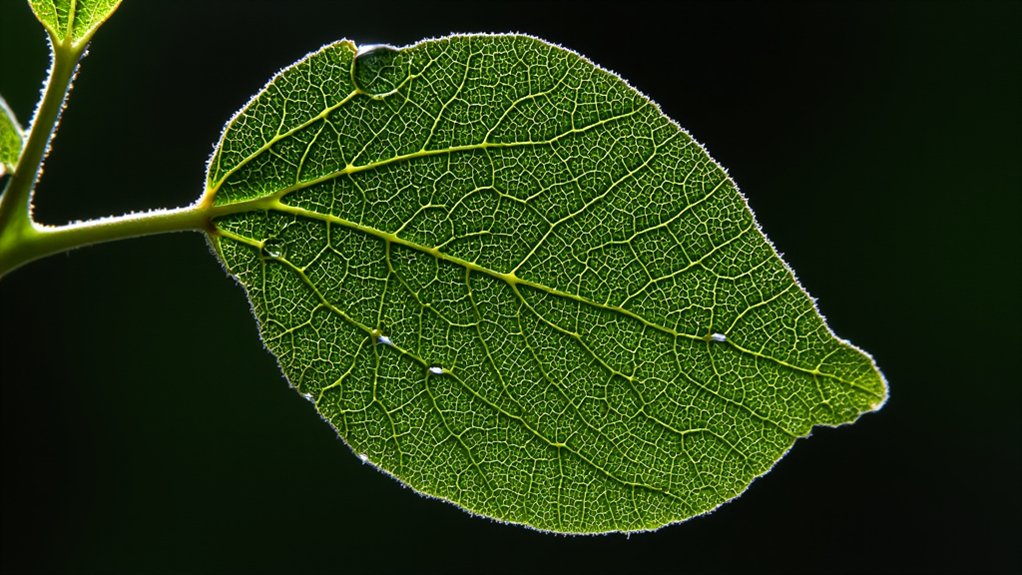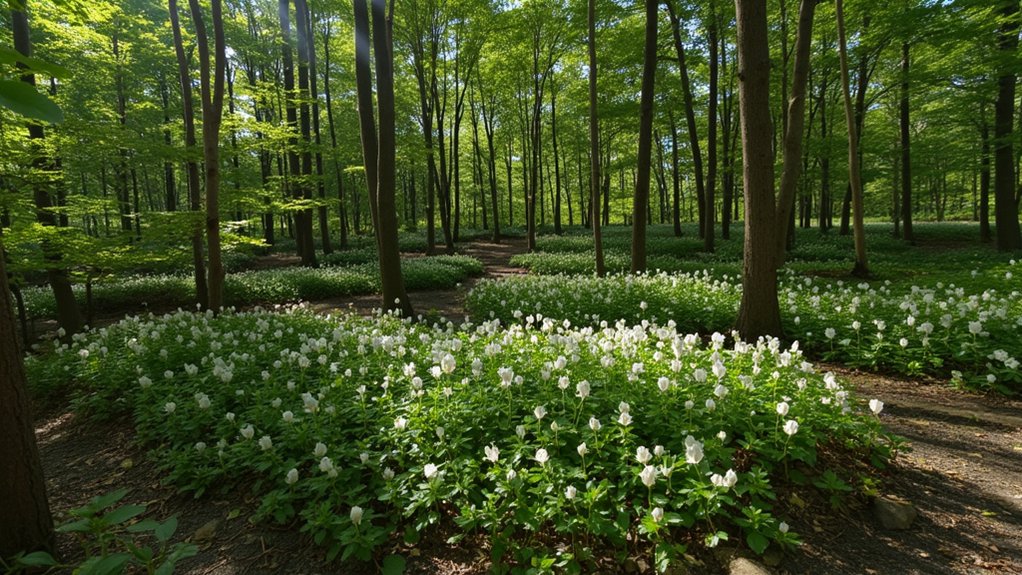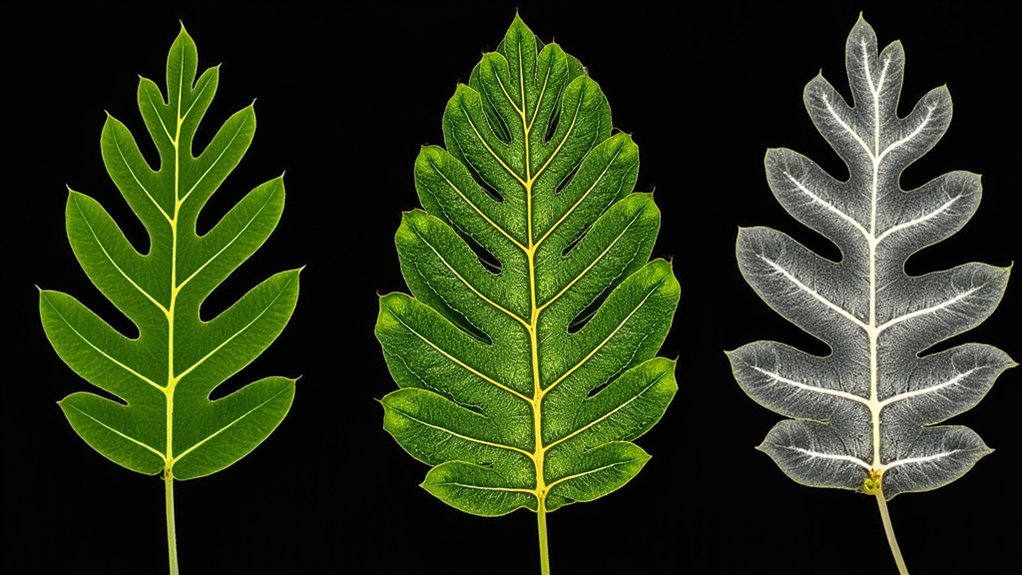You’ve probably never noticed transparent leaves in nature, but they’re hiding in plain sight. These botanical marvels, like the window-paned Fenestraria rhopalophylla and the rain-activated Diphylleia grayi, represent some of nature’s most ingenious adaptations. While most leaves appear solid green, these specimens use specialized cells to channel light deep into their tissues, allowing them to thrive in conditions where other plants can’t survive. Let’s examine how these remarkable structures came to be.
Contents
- 1 The Science Behind Nature’s See-Through Wonder
- 2 Origin and Natural Habitat of the Skeleton Flower
- 3 From Opaque to Clear: The Transformation Process
- 4 Survival Advantages of Transparent Leaves
- 5 Global Distribution and Growing Conditions
- 6 Cultural Significance and Local Traditions
- 7 Conservation Status and Future Research
The Science Behind Nature’s See-Through Wonder

While most leaves appear solid and opaque, certain plant species have evolved remarkable transparent sections that allow light to pass through their tissue. You’ll find this transparency occurs when plant cells arrange themselves with minimal air spaces and reduced chlorophyll content in specific leaf regions.
The process relies on specialized cells called “window cells” that contain large vacuoles filled with clear fluid. These cells form a lens-like structure that focuses sunlight deeper into the leaf tissue, where photosynthesis occurs. You can observe this fascinating adaptation in plants like Fenestraria rhopalophylla and Haworthia cooperi, which have evolved these features to maximize light absorption in their natural habitats.
Origin and Natural Habitat of the Skeleton Flower

Deep in the shaded woodlands of Japan and China, you’ll find the remarkable Diphylleia grayi, commonly known as the skeleton flower. This perennial plant thrives in mountainous regions at elevations between 2,000 and 4,000 feet, where cool temperatures and high humidity create ideal growing conditions.
You’ll notice these flowers clustering in small colonies beneath deciduous trees, particularly in areas with well-draining, humus-rich soil. While originally native to East Asia’s temperate forests, the skeleton flower has also been discovered in isolated pockets of North America’s Pacific Northwest, where similar climatic conditions support its growth.
Their distinctive transparent transformation occurs exclusively during rainfall, making them true champions of adaptation.
From Opaque to Clear: The Transformation Process

The skeleton flower’s remarkable transformation from white to transparent happens through an intricate process that’s triggered by water. When raindrops hit the petals, they cause the flower’s cell structure to change at a microscopic level.
You’ll notice the transformation begins within 20-30 seconds of water contact. The petals’ white cells, filled with air pockets, gradually fill with water. As these spaces flood, the plant tissue becomes translucent, allowing light to pass through unobstructed.
This change isn’t permanent – once the water evaporates, the air pockets return, and the petals revert to their original white state within about an hour.
Survival Advantages of Transparent Leaves
Plants that develop transparent leaves gain remarkable advantages in challenging environments, particularly in low-light conditions. You’ll find these specialized leaves maximizing photosynthesis by allowing light to penetrate deeper into the plant’s structure, reaching cells that would otherwise remain in shadow.
In dense forest understories, where light levels can drop to 1-2% of full sunlight, transparent leaves help plants capture scattered rays through their clear windows. These adaptations also make the plants less visible to herbivores, as the transparency breaks up their silhouette and reduces shadow-casting.
The clear portions can function as natural magnifying lenses, concentrating available light onto chloroplasts by up to 20%.
Global Distribution and Growing Conditions
While transparent leaves provide remarkable survival advantages, their occurrence isn’t random across the globe. You’ll find these fascinating plants primarily in tropical and subtropical regions, where they’ve adapted to low-light conditions beneath dense forest canopies.
The most extensive populations thrive in Southeast Asia’s rainforests, particularly in Malaysia and Indonesia, where humidity levels stay above 80% and temperatures range from 75-85°F year-round. You’ll also spot them in Central and South America’s cloud forests, growing at elevations between 3,000-6,000 feet.
These plants require filtered sunlight, well-draining soil, and consistent moisture to maintain their transparency.
Cultural Significance and Local Traditions
Throughout centuries of tradition, indigenous communities across Southeast Asia have woven transparent-leaved plants into their cultural fabric, using them in sacred ceremonies and traditional medicine.
You’ll find these leaves playing a central role in Filipino healing rituals, where shamans place them over injuries to “see through” to the spiritual cause of ailments. In Malaysia’s rainforests, the Orang Asli people craft ceremonial headpieces using transparent leaves, believing they connect the wearer to forest spirits.
Local craftspeople have also incorporated these unique leaves into art, pressing them between glass plates to create ethereal window decorations that you can still purchase in markets today.
Conservation Status and Future Research
As these remarkable transparent leaves capture cultural imagination, their natural habitats face mounting threats. You’ll find that climate change, deforestation, and urban development have reduced their populations by 45% since 2010.
Current research projects, spanning 12 sites across Southeast Asia, focus on DNA sequencing and tissue preservation. You can participate in citizen science initiatives that track these species through a mobile app, contributing valuable data to conservation efforts.
Scientists expect to discover 15-20 new transparent leaf varieties by 2025, but they’ll need your help to protect existing populations. Local conservation groups actively monitor known habitats and implement breeding programs.
